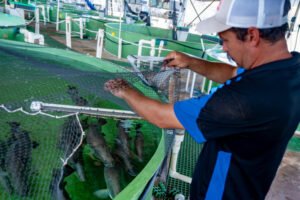Wednesday, 17 December 2025
Harnessing AI to Build Smarter, Safer Food Supply Chains
Josh Smart, Practice Leader and Chief Sales Officer for HUB’s Agribusiness, Food and Cannabis Practice As food supply chains grow more complex and customer expectations rise for safety, traceability, and…

Josh Smart, Practice Leader and Chief Sales Officer for HUB’s Agribusiness, Food and Cannabis Practice
As food supply chains grow more complex and customer expectations rise for safety, traceability, and sustainability, the pressure on food producers and distributors to adapt has never been greater. From managing perishable inventory to mitigating risks in transit, the challenges are as urgent as they are varied.
Enter HUB International’s Supply Chain AI Risk Solutions, developed in partnership with Throughput.AI. Leveraging artificial intelligence, predictive analytics, and real-time tracking, this solution is transforming how food and agribusinesses anticipate demand, manage logistics, and protect their bottom line.
In this exclusive interview with NUFFOODS Spectrum, Josh Smart, Practice Leader and Chief Sales Officer for HUB’s Agribusiness, Food and Cannabis Practice, explains how AI-powered risk management is helping food companies reduce waste, improve efficiency, and weather supply chain disruptions. He also unpacks the unique benefits of stock throughput insurance and highlights how combining data from point-of-sale systems with GPS temperature tracking is changing the game for food safety and responsiveness.
How does HUB Supply Chain AI Risk Solutions specifically tackle the unique challenges of managing perishable inventory in the food industry?
This Solution has many broad applications, one potential application is the management of perishable inventory. Our approach to this type of inventory, as with non-perishable inventory, is an emphasis on how long that inventory is in cold storage as a reflection of incurred expenses before profit can be realised. One of the key outcomes of our partnership with Throughput.AI is to minimise inventory backlog through better analysis and forecasting of market demand. Sometimes this is an unavoidable part of cold chain logistics. I would add that almost no perishable product is sold without a box, bag, packaging, or container, so while the inventory itself might be shelf stable while in CA warehousing, there should never be a delivery delay because the packaging could make it on time. Our Solution would focus on all potential inventory, even packing inventory, watching for replenishment and lead time forecasting for all components of a successful delivery.
What is the role of real-time temperature and GPS tracking in ensuring food safety and adherence to industry regulations?
Our perspective on this question focuses on the transit exposure. Proper tracking of the inventory, including the actual temperature of the refrigerated trailer, would allow for the shipper to verify that the load makes it on time and at a temperature that doesn’t put the inventory at risk of spoilage.
How can food manufacturers and distributors leverage the AI-powered demand sensing and replenishment features to minimise food waste and optimise inventory levels?
One possible outcome, as you mentioned, for a manufacturer is leveraging Throughput.AI’s forecasting module to accurately predict demand and optimise production schedules, reducing overproduction and minimising waste due to spoilage. In addition to forecasting, it can also analyse downstream buyer tendencies for seasonality, potentially changing how much is manufactured during certain times of the year.
In what ways does stock throughput insurance offer enhanced risk coverage for the food industry compared to traditional cargo or property insurance policies?
Property policies only cover inventory while at a scheduled location for defined perils (or at least comparably more limited versus a Stock Throughput policy). Stock Throughput is a coverage that insures stock/inventory while in storage and also later when it’s in transit by any mode (air, sea, rail, road) from warehouse to final destination anywhere in the world. The coverages are often significantly broader with bespoke policy language that can fit the client and their needs directly, including catastrophic perils (earthquake and flood). Cargo, sometimes called Inland Marine, is a transit insurance policy that covers inventory while in domestic transit for covered causes of loss.
How does the integration of point-of-sale data with Throughput AI enable food businesses to swiftly adapt to changes in consumer demand or disruptions within the supply chain?
Throughput.AI’s program allows for an upstream and downstream supply chain view for a client’s supply chain (raw materials or component parts through to final product). Certainly the tool can see the client’s suppliers (current and historical) as well as their clients and the supply chain patterns each side has experienced as far back into the past as we have data. But, and maybe to your question, it’s not a macro supply chain AI tool that’s leveraging thousands of other clients integrated into the Throughput.AI platform to alert any single specific customer of a potential problem with inventory management because they are seeing a facility making component parts fail to deliver, and therefore making proactive recommendations to raising the alarm for unaffected or forthcoming deliveries.
Are there any examples or case studies you can share that illustrate how food and agribusiness clients have already benefited from this solution in managing supply chain disruptions?
We have seen many types of clients engage the tool, from food companies with a few hundred SKUs to large, muti-national food companies with thousands of SKUs spread across multiple countries. Both private and publicly traded firms have seen tremendous value in the implementation of our HUB Supply Chain AI Risk Solution which has allowed clients to recapture nested capital and leverage their own inventory management to recapture some profits…and who doesn’t want more cash on their balance sheet!
Shraddha Warde
shraddha.warde@mmactiv.com
Technology
Nfinite secures funding to scale up breakthrough paper packaging solution
Dec 17, 2025 | Company News
Silal–Square Roots partnership uses AI to boost sustainable food production
Dec 17, 2025 | Company News
Food Testing
Australia’s Humpty Doo Barramundi farm to achieve ASC certification
Dec 08, 2025 | Australia
SFDA and Turkish Halal Accreditation Agency forge strategic partnership
Dec 05, 2025 | Food
Fish freshness easily monitored with a new sensor
Dec 04, 2025 | Food Safety and Testing
More Popular
Nfinite secures funding to scale up breakthrough paper packaging solution
Dec 17, 2025 | Company News
Silal–Square Roots partnership uses AI to boost sustainable food production
Dec 17, 2025 | Company News
Korea's Samson Food broadens seafood portfolio with hwangto salt-based products
Dec 17, 2025 | Company News






